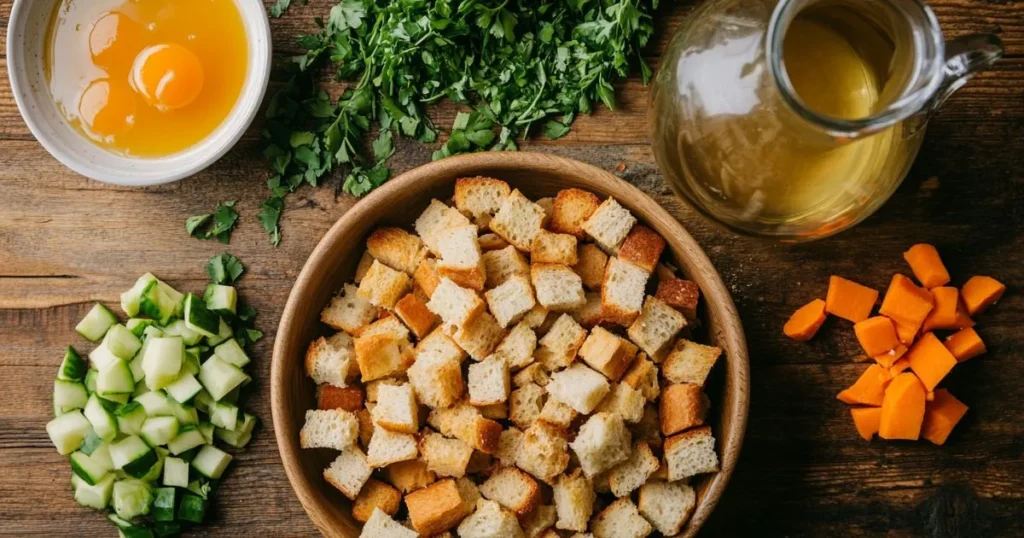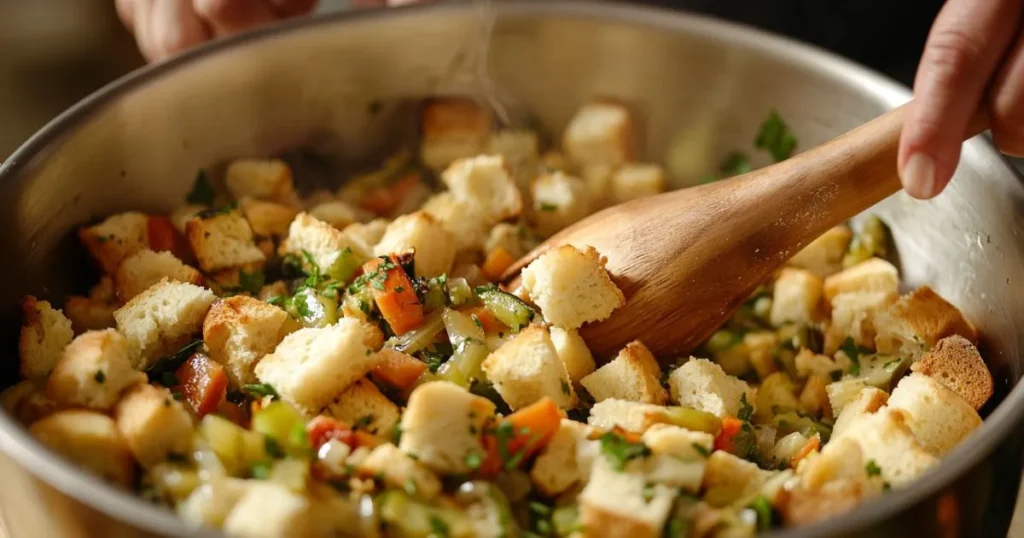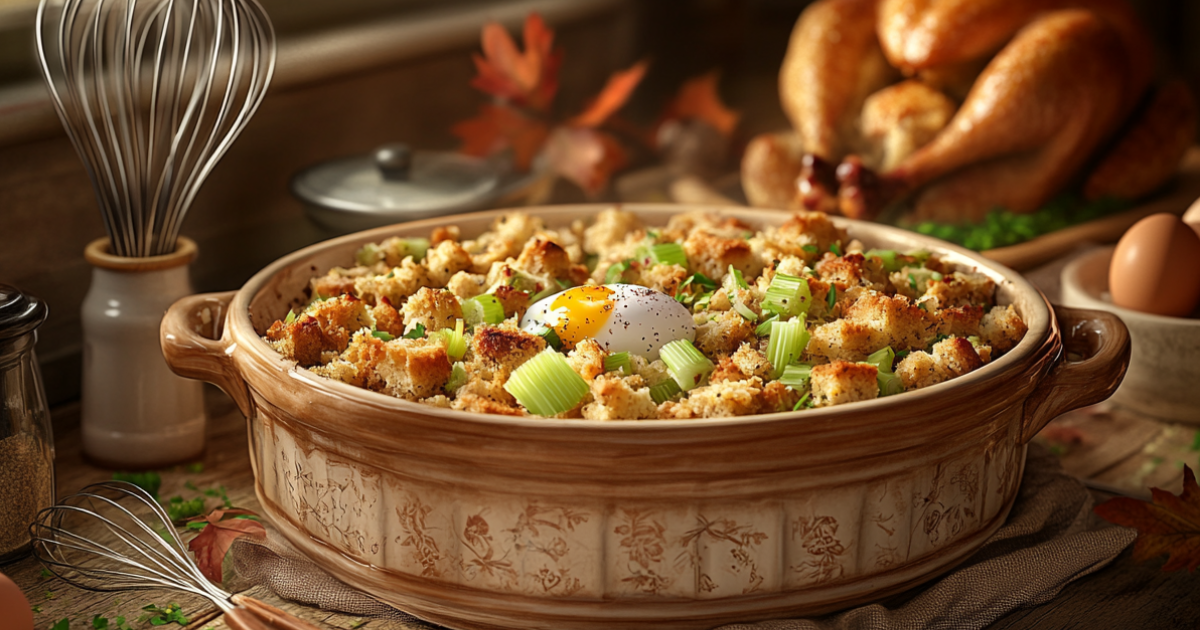Introduction
The Essential Role of Eggs in Turkey Stuffing
When it comes to crafting the perfect turkey stuffing, eggs play a surprisingly essential role. So, why add eggs to turkey stuffing? Eggs act as a binding agent, helping to hold the stuffing ingredients together and create a cohesive texture. Without eggs, your stuffing may crumble apart when served, making it harder to enjoy with the turkey or gravy.
Additionally, eggs provide a subtle richness to the stuffing, elevating its overall flavor profile. Their neutral taste blends seamlessly with the other ingredients, from herbs and seasonings to bread cubes and vegetables, ensuring a balanced, delicious result.
Whether you’re preparing a classic stuffing recipe or experimenting with unique flavors, eggs remain a versatile ingredient that enhances both structure and taste. By adding eggs to turkey stuffing, you ensure a dish that’s not only flavorful but also easy to serve and enjoy.
How Eggs Elevate the Texture of Turkey Stuffing
A standout feature of eggs in turkey stuffing is how they improve texture. Why add eggs to turkey stuffing? Because they help achieve a moist yet firm consistency. The proteins in eggs coagulate during cooking, binding the stuffing together without making it dry or overly dense. This ensures your stuffing has the perfect balance of softness and structure.
Furthermore, eggs prevent the stuffing from falling apart when sliced or served, which is especially important when stuffing is cooked separately from the turkey. A properly bound stuffing offers a better mouthfeel, making each bite more satisfying.
Do Eggs Make Turkey Stuffing Healthier?
Beyond flavor and texture, eggs can contribute to the nutritional value of your turkey stuffing. Why add eggs to turkey stuffing? Eggs are a natural source of high-quality protein, essential vitamins, and minerals. When included in your stuffing, they increase its protein content, making the dish more filling and nutritious.
Eggs are rich in vitamins like B12, which supports energy production, and minerals like selenium, which aids in immune health. These nutrients can help round out the nutritional profile of a stuffing recipe that may otherwise be heavy on carbohydrates.
By incorporating eggs, you can create a stuffing that not only tastes great but also offers more balanced nutrition. This small addition can make a big difference, especially during the holiday season when indulging responsibly becomes a priority.
Table of Contents
Recipe History
The Tradition of Turkey Stuffing Across Cultures
The tradition of stuffing dates back centuries and spans cultures around the world. While turkey stuffing is a classic in American holiday celebrations, the concept of filling poultry or other meats with a flavorful mixture has its origins in ancient times. From the rice- and herb-based stuffing of Middle Eastern cuisine to the bread-based varieties popularized in Europe, this culinary technique has always been about enhancing flavor and texture.
But why add eggs to turkey stuffing in the modern American context? Over time, stuffing recipes evolved to include binding agents like eggs to create a firmer texture and better hold ingredients together. This evolution has turned a simple side dish into an integral part of Thanksgiving and other holiday feasts.
Ingredients and Preparation
Choosing the Best Eggs for Turkey Stuffing
When preparing turkey stuffing, the quality of the eggs you use can make a big difference. Why add eggs to turkey stuffing? To achieve the best flavor and texture, it’s important to select fresh, high-quality eggs. Look for eggs labeled as “organic” or “pasture-raised,” as they often have a richer yolk and better flavor profile compared to conventional options.

Including eggs in your turkey stuffing doesn’t have to be complicated. Here’s a simple step-by-step guide to follow:
Step-by-Step Preparation with Eggs in Stuffing
- Prepare the Ingredients: Dice your bread into cubes, chop the vegetables, and gather your herbs and spices.
- Whisk the Eggs: Beat the eggs in a bowl until the yolks and whites are fully combined. This step ensures even distribution throughout the stuffing mixture.
- Combine Ingredients: In a large mixing bowl, toss the bread cubes with the sautéed vegetables, seasonings, and beaten eggs. Slowly add broth to reach your desired level of moisture.
- Transfer and Cook: Place the stuffing in a greased baking dish or stuff it directly into the turkey cavity. Bake according to your recipe’s instructions, ensuring the eggs are fully cooked for food safety.
Following these steps ensures that the eggs enhance the texture and flavor of your turkey stuffing without overwhelming the other ingredients.
Common Mistakes to Avoid When Using Eggs
Even seasoned cooks can encounter challenges when using eggs in stuffing. Why add eggs to turkey stuffing if the preparation isn’t perfect? Here are a few common mistakes to avoid:
- Not Beating the Eggs: Failing to properly whisk the eggs can lead to uneven distribution, causing some parts of the stuffing to be overly dense while others remain crumbly.
- Overloading on Eggs: Adding too many eggs can result in a rubbery texture, which detracts from the dish’s appeal. Stick to the recommended bread-to-egg ratio for the best results.
- Skipping Food Safety Checks: Always ensure that the eggs are fully cooked, especially if the stuffing is baked inside the turkey. Use a meat thermometer to verify an internal temperature of 165°F.
- Adding Eggs Too Late: Eggs should be added to the stuffing mixture before the broth to ensure they properly bind the ingredients together.
Avoiding these pitfalls will help you make a stuffing that’s both delicious and structurally sound, enhancing your overall holiday meal experience.
Serving Suggestions
How to Serve Turkey Stuffing with Eggs for Holiday Meals
Turkey stuffing enhanced with eggs deserves a spot at the center of your holiday table. Why add eggs to turkey stuffing? Because their binding quality creates a visually appealing dish that holds its shape beautifully when served. For a classic presentation, scoop the stuffing into a large, decorative serving dish, garnished with fresh herbs like parsley or thyme.
If you’re serving stuffing as part of a plated meal, portion it using a round or oval mold for an elegant, uniform look. Pair it with turkey slices, gravy, and vibrant vegetable sides for a complete, festive plate. By showcasing the texture and flavor eggs bring to the dish, your stuffing will earn its well-deserved spotlight during the holidays.
Pairing Your Turkey Stuffing with Other Dishes
Why add eggs to turkey stuffing? Not only do they improve the stuffing’s texture, but they also make it a versatile side dish that pairs well with numerous flavors. Classic pairings include turkey, cranberry sauce, and mashed potatoes, creating a harmonious blend of savory and sweet.
For a modern twist, serve your stuffing with roasted Brussels sprouts or a crisp arugula salad to balance the richness of the dish. Adding a glass of dry white wine or a non-alcoholic sparkling cider can further elevate the dining experience, making your holiday meal feel cohesive and indulgent.
Creative Leftover Ideas with Turkey Stuffing and Eggs
Leftovers don’t have to be boring, especially when your stuffing includes eggs. Why add eggs to turkey stuffing? Because it makes leftovers even more versatile! Here are a few creative ideas:
- Stuffing Waffles: Press leftover stuffing into a waffle iron for a crispy, savory breakfast. Top with a fried egg for added richness.
- Stuffing Frittata: Mix leftover stuffing with additional eggs and bake it in a skillet for a quick and hearty frittata.
- Stuffing-Stuffed Peppers: Use stuffing as a filling for bell peppers, then bake until tender for a quick and nutritious meal.
- Stuffing Hash: Sauté stuffing with diced turkey, potatoes, and vegetables for a flavorful hash, perfect for brunch.
These ideas ensure you make the most of your stuffing while showcasing its adaptability and deliciousness.
Tips for Presenting Turkey Stuffing at the Table
Presentation matters, especially during holiday feasts. To showcase your turkey stuffing with eggs, serve it in a dish that complements your table’s theme. Rustic ceramic or cast iron dishes work well for traditional settings, while sleek, minimalist platters suit modern decor.
Garnish the stuffing with fresh herbs or a sprinkle of breadcrumbs for added visual appeal. If serving buffet-style, keep the stuffing warm in a chafing dish to maintain its texture and flavor throughout the meal. Finally, provide a serving spoon that makes it easy to portion without breaking the stuffing apart—another benefit of adding eggs to the dish!
Cooking Techniques
Mixing Eggs Properly for Even Distribution
One of the keys to successful turkey stuffing is properly mixing the eggs to ensure even distribution throughout the dish. Why add eggs to turkey stuffing if they aren’t mixed thoroughly? Uneven mixing can lead to parts of the stuffing being overly dense while others crumble apart.
To achieve the perfect consistency, beat the eggs in a separate bowl until the yolks and whites are fully combined. Add the beaten eggs to the stuffing mixture gradually, tossing gently to coat the bread cubes and other ingredients evenly. Using a wide mixing bowl can make the process easier and help prevent overmixing, which can break down the bread cubes.
This technique ensures that every bite of stuffing has the right balance of flavors and textures, making it a centerpiece-worthy addition to your holiday table.

Tips for Baking Turkey Stuffing with Eggs to Perfection
Why add eggs to turkey stuffing? Their role in baking is crucial for achieving the ideal texture. When baking stuffing, the eggs cook and set, creating a firm yet tender consistency. To ensure your stuffing is baked to perfection, follow these tips:
- Preheat the Oven: Always start with a fully preheated oven to ensure even cooking.
- Cover, Then Uncover: Bake the stuffing covered with foil for the first half of the cooking time to lock in moisture, then uncover it to allow the top to crisp up.
- Use a Meat Thermometer: If the stuffing is baked inside the turkey, check the internal temperature of the stuffing—it must reach 165°F to be safe to eat.
- Choose the Right Dish: For stuffing baked separately, use a shallow baking dish to ensure even heat distribution and a crispy top layer.
By following these baking tips, you’ll ensure the eggs work their magic, binding the stuffing and creating a perfectly cooked dish.
The Role of Eggs in Preventing Soggy Stuffing
Soggy stuffing is a common concern for many cooks. Why add eggs to turkey stuffing? Eggs help prevent sogginess by creating a structure that absorbs moisture evenly without becoming overly wet. The proteins in eggs solidify as they cook, ensuring the stuffing retains its shape and consistency.
To avoid sogginess, it’s essential to use the right amount of broth along with the eggs. Add the liquid gradually, stirring gently to ensure the bread cubes absorb it evenly. If the stuffing feels overly wet, bake it uncovered for a bit longer to allow excess moisture to evaporate.
Thanks to the binding power of eggs, you can achieve a stuffing that’s moist yet firm, with a texture that’s enjoyable for all your guests.
Adjusting Cooking Time Based on Egg Quantity
Why add eggs to turkey stuffing if you’re not prepared to adjust the cooking time? The number of eggs used in a recipe can slightly alter the baking process. More eggs generally mean the stuffing will take a bit longer to cook as the proteins need time to set fully.
FAQ
Can You Make Turkey Stuffing Without Eggs?
Yes, you can make turkey stuffing without eggs, but the texture and consistency may be affected. Why add eggs to turkey stuffing? Eggs act as a binding agent, holding the ingredients together and creating a moist, cohesive texture. Without eggs, the stuffing can become crumbly and may not hold its shape when served.
For those who prefer egg-free stuffing, there are alternatives. Common substitutes include flaxseed meal mixed with water, mashed potatoes, or unsweetened applesauce. While these alternatives can mimic the binding properties of eggs, they may slightly alter the flavor and texture of the dish. Experimenting with substitutes can help you find an option that works best for your preferences and dietary needs.
Should Eggs Be Beaten Before Adding Them to Stuffing?
Yes, eggs should always be beaten before adding them to stuffing. Why add eggs to turkey stuffing if they aren’t properly prepared? Beating the eggs ensures that the yolks and whites are fully combined, allowing for even distribution throughout the stuffing mixture.
Adding unbeaten eggs directly to the mixture can result in clumps of egg, which may cook unevenly and create an inconsistent texture. To avoid this, whisk the eggs in a separate bowl until smooth before incorporating them into the stuffing. This small step makes a big difference in achieving a cohesive and evenly cooked dish.
How Many Eggs Should You Use in Turkey Stuffing?
The number of eggs you should use depends on the size of your recipe. Why add eggs to turkey stuffing? The ideal amount helps bind the ingredients together while maintaining a moist texture. A general guideline is to use one egg for every two to three cups of bread cubes.
If you prefer a firmer stuffing, you can add an extra egg. However, adding too many eggs can result in a heavy or rubbery texture, so it’s important to strike the right balance. Adjusting the ratio based on your preferences ensures your stuffing comes out perfect every time.
Do Eggs Impact the Shelf Life of Turkey Stuffing?
Yes, eggs can impact the shelf life of turkey stuffing. Why add eggs to turkey stuffing if they might affect storage? While eggs enhance the flavor and texture of stuffing, they also make it more perishable. Cooked stuffing containing eggs should be stored in the refrigerator within two hours of cooking and consumed within three to four days.
If you need to store stuffing for longer, freezing is a great option. Allow the stuffing to cool completely, portion it into airtight containers, and freeze for up to three months. When reheating, ensure the stuffing reaches an internal temperature of 165°F to maintain food safety.
Proper storage and reheating techniques ensure that your egg-based stuffing remains fresh and delicious, even as leftovers.
Conclusion
The Benefits of Adding Eggs to Turkey Stuffing Summarized
Why add eggs to turkey stuffing? The answer lies in their unmatched ability to transform a simple side dish into a culinary masterpiece. Eggs play a crucial role as a binding agent, ensuring the stuffing holds its shape and has the perfect moist-yet-structured texture. Additionally, eggs elevate the dish’s flavor while contributing essential nutrients like protein, vitamins, and minerals.
By including eggs in your turkey stuffing, you enhance its overall quality and presentation. This simple yet impactful ingredient makes your stuffing both a crowd-pleaser and a source of pride on your holiday table.
Incorporating Eggs for Better Texture and Taste
The addition of eggs to turkey stuffing guarantees better texture and taste, making it a standout part of your meal. Their unique binding properties ensure that every bite is cohesive and satisfying, while their rich flavor complements the savory herbs and spices in the recipe.
Why add eggs to turkey stuffing? Because they ensure the dish is as delicious as it is visually appealing. Whether you’re serving stuffing baked inside the turkey or as a standalone side, eggs elevate the dish to a professional level of quality.
Final Tips for Perfect Turkey Stuffing
To master the art of turkey stuffing, remember these key tips:
- Use the recommended bread-to-egg ratio to achieve the ideal consistency.
- Whisk eggs thoroughly before incorporating them into the stuffing mixture.
- Monitor the internal temperature to ensure the stuffing is fully cooked, especially when baked inside the turkey.
- Experiment with herbs, spices, and add-ins, but let eggs remain the binding cornerstone of the dish.
By following these tips, your turkey stuffing will consistently impress. For more inspiration, check out these related recipes:
- Turkey Casserole with Stuffing
- Do You Fully Cook Stuffing Before Putting It in the Turkey?
- Why Is My Turkey Stuffing Soggy?
With these insights, you’re ready to create a turkey stuffing that’s not just a side dish but a highlight of your holiday feast.

